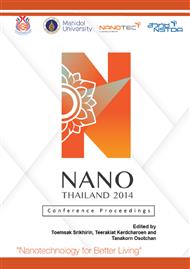[1]
L. Cormier, Structural changes between soda-lime silicate glass and melt, J. Non-Cryst. Solids, 357 (2011) 926–931.
DOI: 10.1016/j.jnoncrysol.2010.10.014
Google Scholar
[2]
R. Buntem, Personal communication, (2006).
Google Scholar
[3]
A. Terczynska-Madej, K. Cholewa-Kowalska, M. Laczka, The effect of silicate network modifiers on colour and electron spectra of transition metal ions, Opt. Mater., 32 (2010) 1456–1462.
DOI: 10.1016/j.optmat.2010.05.024
Google Scholar
[4]
P.Y. Shih, T.S. Chin, Effect of redox state of copper on the properties of P2O5-Na2O-CuO glasses, Mater. Chem. Phys. 60 (1999) 50-57.
DOI: 10.1016/s0254-0584(99)00070-x
Google Scholar
[5]
G.D. Khattak, A. Mekki, L.E. Wenger, Local structure and redox state of copper in tellurite glasses, J. Non-Cryst. Solids 337 (2004) 174–181.
DOI: 10.1016/j.jnoncrysol.2003.08.088
Google Scholar
[6]
J. Lee, T. Yano, S. Shibata, A. Nukui, M. Yamane, EXAFS srudy on the local environment of Cu+ ions in glasses of the Cu2O-Na2O-Al2O3-SiO2 system prepared by Cu+/Na+ ion exchange, J. Non-Cryst. Solids, 277 (2000), 155-161.
DOI: 10.1016/s0022-3093(00)00330-6
Google Scholar
[7]
T. Honma, D. Oku, T. Komatsu, Formation and its mechanism of copper metal layers at surface by annealing in reduced atmosphere in CuO–Li2O–Nb2O5–SiO2 Glass, Solid State Ionics 180 (2009) 1457–1462.
DOI: 10.1016/j.ssi.2009.09.002
Google Scholar
[8]
L. Kido, M. Müller, C. Rüssel, Redox reactions during temperature change in soda-lime–silicate melts doped with copper and iron or copper and manganese, J. Non-Cryst. Solids 352 (2006) 4062–4068.
DOI: 10.1016/j.jnoncrysol.2006.06.027
Google Scholar
[9]
E. Meechoowas, M. Müller, C. Rüssel, Redox relaxation in a sodium borosilicate glass doped with copper and arsenic, antimony, or tin, J. Non-Cryst. Solids 356 (2010) 2528–2533.
DOI: 10.1016/j.jnoncrysol.2010.03.034
Google Scholar
[10]
B. Ravel, M. J. Newville, ATHENA, ARTEMIS, HEPHAESTUS: data analysis for X-ray absorption spectroscopy using IFEFFIT, Synchrotron Rad. 12 (2005) 537-541.
DOI: 10.1107/s0909049505012719
Google Scholar
[11]
E.M.A. Khalil, F.H. ElBatal, Y.M. Hamdy, H.M. Zidan, M.S. Aziz, A.M. Abdelghany, Infrared absorption spectra of transition metals-doped soda lime silica glasses, Physica B 405 (2010) 1294–1300.
DOI: 10.1016/j.physb.2009.11.070
Google Scholar
[12]
A. Gritco, M. Moldovan, R. Grecu, V. Simon, Thermal and Infrared analyses of aluminosilicate glass systems for dental implants, J. Optoelectron. Adv. M. 7 (2005) 2845 – 2847.
Google Scholar
[13]
W. Junpeng, C. Jinshu, L. Ping, The coordination state of B and Al of borosilicate glass by IR spectra, J. Wuhan Univ. Technol. (2008) 419-421.
DOI: 10.1007/s11595-007-3419-9
Google Scholar
[14]
W. Klysubun, Y. Thongkam, S. Pongkrapan, K. Won-in, J. T-Thienprasert and P. Dararutana, XAS study on copper red in ancient glass beads from Thailand, Anal. Bioanal. Chem. 399 (2011) 3033–3040.
DOI: 10.1007/s00216-010-4219-1
Google Scholar
[15]
A. Gaur, B. D. Shrivastava, S. K. Joshi, Copper K-edge XANES of Cu(I) and Cu(II) oxide mixtures, J. Phys.: Conf. Ser. 190 (2009) 1-4.
DOI: 10.1088/1742-6596/190/1/012084
Google Scholar


